Photovoltaic Cells Information
Photovoltaic cells or solar cells generate a voltage when radiant energy falls on the boundary between dissimilar substances. The photovoltaic process converts the energy of the sun directly into electricity using solar cells. This conversion is called the photovoltaic effect. The light hitting the solar cell produces both voltage and current to generate electrical power.
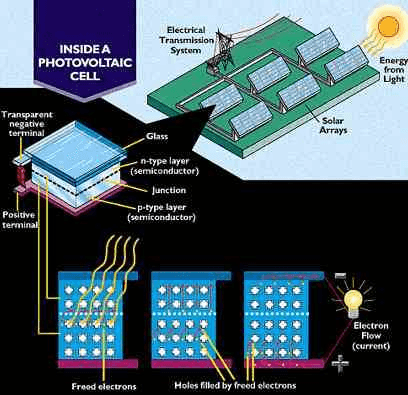
How photovoltaic cells work. Image Credit: inventors.about.com
Solar cells must be built with special materials, usually silicon crystal, in which the absorption of light releases electrons. A solar panel, also called a photovoltaic panel, is a group of photovoltaic cells that are enclosed to keep the cells safe and so that the voltage obtained from each cell can be combined. They are usually made using semiconductor materials in the form of a p-n junction (a typical diode).
Semiconductors are differentiated by the band gap energy and the band gap type. Band gap energy is the energy needed to allow an electron in an atom's shell to break away from the atom and flow freely in the material. The higher the band gap energy the higher the energy of light required to release an electron so it conducts current. If the band gap is too high then few photons have enough energy, which results in low current and low power. If the band gap energy is too low then all the photons produce the same low voltage which also leads to low power.
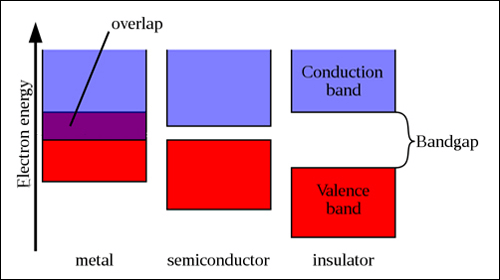
Image Credit: solarcellcentral.com
There are two types of band gap: direct and indirect. Direct band gap has higher efficiency in creating free electrons since only a photon is required to release an electron. This type is also thinner than indirect band gap material. Indirect band gap requires a small amount of kinetic energy that cannot come from a photon, but comes from the momentum of other particles. It is less efficient and therefore requires thicker material.
Photovoltaic Cell Materials
Solar cell materials are generally group IV elements on the periodic table (titanium, zirconium, hafnium, rutherfordium).
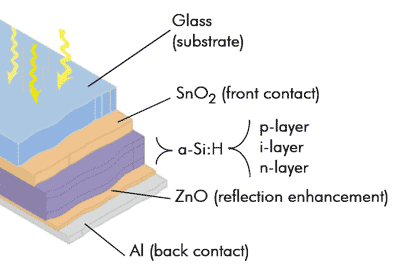
Image Credit: azom.com
-
Silicon is the second most abundant element in the Earth's crust and it is therefore much cheaper than other semiconductor materials. Since it links well with the energy of visible sunlight it is the dominant material used for solar cells.
-
Advantages: Abundant and inexpensive to process, non-toxic, and used in electronics so it is well studied and understood.
-
Disadvantages: weak absorber of light and a band gap lower than ideals for solar spectrum. Silicon is indirect, but it is much cheaper than other elements.
-
Examples include: Amorphous silicon, monocrystalline silicon, polycrystalline silicon, ribbon silicon.
-
-
Germanium is widely used in electronics and was the dominant material in the early market. Now it is being combined with silicon.
-
Advantages: Germanium has low impurities that can reduce cell output and can be used in amorphous and crystalline forms.
-
Disadvantage: Poor semiconductor property of indirect band gap; band gap is too small for high efficiency cells.
-
-
Gallium arsenide cells are multifunction cells that are more efficient than silicon but have a high cost and toxicity.
-
Advantages: Electrons have longer lifetime and generates current easily. It is more efficient due to direct band gap.
-
Disadvantages: Gallium arsenide has no natural insulating layer to prevent impurities from shorting the cell. It is also expensive.
-
-
Selenium is expensive and difficult to obtain and therefore too expensive for commercial use. It is well-suited to the solar spectrum since most photons have sufficient energy and few have too much.
|
Material |
Gap Type |
Gap Energy |
|
Silicon (Si) |
Indirect |
1.1 eV |
|
Germanium (Ge) |
Indirect |
0.66 eV |
|
Cadmium Telluride (CdTe) |
Direct |
1.56 eV |
|
Gallium Arsenide (GaAs) |
Direct |
1.42 eV |
|
Copper Indium Diselenide (CIS) |
Direct |
2.4 eV |
|
Copper Indium Gallium Selenide (CIGS) |
Direct |
1.5 eV |
Silicon Photovoltaic Cells
There are three basic types of photovoltaic cells: mono-crystalline cells, polycrystalline cells, and amorphous cells. Crystalline silicon is the most common material for commercial applications. It has a well-known standard process because silicon is abundant. However, it requires expensive highly pure silicon and competes for silicon with electronics industry.
-
A mono-crystalline cell is the most efficient, but also the most costly photovoltaic cell.
-
A polycrystalline cell is more common and less expensive, but also less efficient.
-
An amorphous cell is relatively inexpensive, but produces much less power. As such, the solar panels made from these photovoltaic cells must be larger to produce the same amount of energy. A UV-sensitive photo cell converts UV radiation to electrical energy.
|
Crystal Type |
Symbol |
Crystal Grain Size |
Common Growth Techniques |
|
Single-crystal |
sc-Si |
> 10 cm |
Czochralski (Cz), Float-Zone (FZ) |
|
Multicrystalline |
mc-Si |
10cm |
Cast, spheral, sheet, ribbon |
|
Polycrystalline |
pc-Si |
1mm – 1mm |
Evaporation , CVD, sputtering |
Photovoltaic Cell Specifications
A photovoltaic system contains individual solar panels that convert the solar energy into usable direct current (DC) electricity that can then be distributed through an inverter to the electric grid or the utility panels at industrial sites or even in houses. Photovoltaic cells are generally connected to form solar panels. Solar panels can also be combined to produce currents used in a variety of applications. A photovoltaic system is composed of a cell, panel, and array.
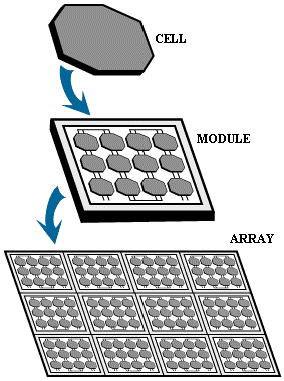
Image Credit: wikipedia
Specifications include:
-
Power - The output power of the solar cell.
-
Efficiency - The efficiency of the solar cell.
-
Open circuit voltage - The open circuit voltage is the maximum voltage of the cell when the device is under infinite load, or in an open-circuit situation.
-
Short circuit current- The short circuit current is the maximum current when the cell is under zero load.
-
Peak voltage - The maximum voltage produced by the panel or cell.
-
Peak current - The maximum current produced by the panel or cell.
In order to design a photovoltaic system there are several steps that must be considered. The total load current and operational time should be determined and then system losses can be added. Load refers to all the devices in the system that consume electrical power. Additional design rules include determining the solar irradiation in daily equivalent sun hours, the total solar array current requirements, optimum module arrangement for the solar array, and battery size for recommended reserve time.
Applications
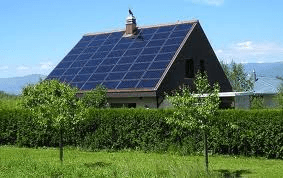
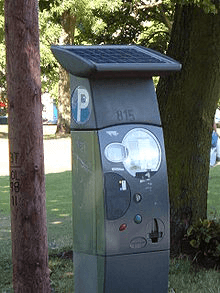
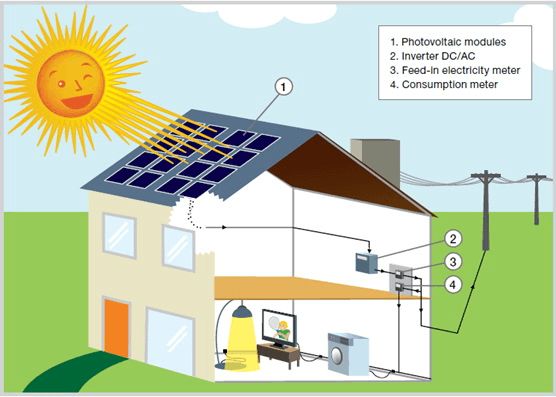
Image Credit:inhabit.com | wikipedia | eupvplatform
Photovoltaic power is reliable, creates no pollution, and can be quickly installed. A photovoltaic cell manufacturer or a solar cell manufacturer can produce this type of cell for many applications, ranging from calculators to satellites to telephones and vehicles. The expected lifetime for photovoltaic cells can be up to 40 years. The time to recoup the cost of a solar panel averages five years, but can range between one to thirty years depending on the type of solar panel and its larger photovoltaic system.
Photovoltaic Standards
|
ASME |
The power generator is ASME certified. |
|
CSA |
Products that bear a CSA Mark have been tested by the Canadian Standards Association (CSA) and meet applicable standards for safety and/or performance. These standards are written and administered by organizations such as the American National Standards Institute (ANSI), Underwriters Laboratories (UL), and CSA International. CSA Marks may appear alone or with indicators. CSA Marks that appear alone are used with products certified primarily for the Canadian market, to the applicable Canadian standards. CSA Marks that appear with the indicators “C” and “US” or “NRTL/C” is used with products certified for both the U.S. and Canadian markets, to the applicable U.S. and Canadian standards. |
|
IEC |
The International Electrotechnical Commission (IEC) is a global, non-profit organization that develops and maintains voluntary quality, safety, and performance standards for electrical materials, products, and systems The IEC also publishes standards for the electronics and telecommunications industries. The IEC’s membership consists of the electrotechnical standards organizations from each of its 51 member nations. The American National Standards Institute (ANSI) represents the United States. |
|
IEEE |
The power generator is IEEE certified. |
|
NFPA |
The power generator is NFPA (National Fire Protection Association) certified. |
|
RoHS Compliant |
Restriction of Hazardous Substances (RoHS) is a European Union (EU) directive that requires all manufacturers of electronic and electrical equipment sold in Europe to demonstrate that their products contain only minimal levels of the following hazardous substances: lead, mercury, cadmium, hexavalent chromium, polybrominated biphenyl, and polybrominated diphenyl ether. RoHS became effective on July 1, 2006. |
|
UL |
Underwriters Laboratories (UL) is a non-profit organization that tests components, systems, and materials according to its published standards for safety. Products that receive UL approval bear a UL Mark. |
|
WEEE Compliant |
“The Waste Electrical and Electronics Equipment Regulations (WEEE Regulations) is a European Parliament Directive with the aim of encouraging reuse, recycling and recovery of electrical and electronic equipment, and to improve the environmental impact and performance of these equipments." This directive sets the requirements and criteria for the collection, treatment, recycling and recovery of these equipments. It makes producers responsible for financing these activities, and retailers and distributors must provide means for consumers to return used or obsolete equipments without charge. |
Resources
Northeast Advanced Technological Education Center - Abe Michelen
- photocell sensor
- silicon solar cells
- monocrystalline solar cells
- photovoltaic system specification
- 100w solar cells
- 3x6 solar cells
- 4x4 solar cells
- 6x6 monocrystalline solar cells
- 6x6 solar cells
- amorphous solar cells
- flexible solar cells
- multijunction photovoltaic cells
- pre tabbed solar cells
- small photovoltaic cells
- type II heterojunction solar cells
